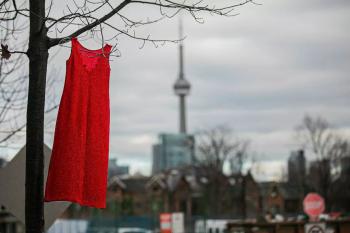Image Caption
Summary
Local Journalism Initiative Reporter
Windspeaker.com
A photograph of one dress in the REDress Project installation now on display in Toronto “invoked some things within” Terrellyn Fearn, the former director of outreach and support services for the National Inquiry into Missing and Murdered Indigenous Women and Girls (MMIWG).
It’s a sleeveless red dress hanging from the branches of a winter-bare tree and in the background is an out of focus CN Tower.
“I thought this is such a powerful image because I think about that CN Tower and what that represents,” including the continued violence by corporations and governments experienced by Indigenous women and the extraction of resources, said Fearn, a member of Glooscap First Nation.
“That tower was named CN after the Canadian National Railway company who built the tower and they were instrumental in clearing the land and disconnecting Indigenous peoples from their land and the disenfranchisement of Indigenous people.”
Fearn was one of four women who spoke Dec. 6 as the Centre for Addiction and Mental Health (CAMH) hosted a panel marking the National Day of Remembrance and Action on Violence Against Women. The virtual event was held on the 32nd anniversary of the shooting deaths of 14 women at the Montreal École Polytechnique, killed because of their gender.
From Dec. 3 to 8, CAMH is hosting the REDress Project, outdoor installation at its Toronto location. It was created by multidisciplinary artist Jamie Black in 2010 to bring awareness to the ongoing tragedy of MMIWG and two-spirit people from gender and race-based violence in Canada.
Each empty red dress on a hanger symbolizes a lost life of an Indigenous woman or girl.
Black joined Fearn on the panel, along with Renee Linklater of Rainy River First Nation, senior director of Shkaabe Makwa, the Centre for First Nation, Métis and Inuit Wellness at CAMH.
Black says that over the years she has come to see the red dresses in a more spiritual way, standing with those who are still living and still fighting.
“I think that these dresses are evoking the violence we are experiencing as Indigenous women and girls but they're also evoking our presence, our spiritual presence and the power of that. You can't look away,” said Black.
She says the dresses are also reclaiming the spaces that have been taken from Indigenous communities since colonization.
The REDress installations “have been in so many different spaces, but they’ve reclaimed space in colonial institutions. They're reclaiming space on the streets of Toronto right now. They're just making people have the conversations that are necessary to create a safer space for women and girls,” said Black.
For CAMH, Canada's largest mental health and addiction teaching hospital and a world leading research centre in the field, the REDress installation is part of working towards mental health for Indigenous people.
“As an organization that is committed to truth and reconciliation, it is our responsibility to recognize and better understand the issue of missing and murdered Indigenous women and girls and two-spirit peoples, including educating ourselves on how it ties into the mental health and well-being of Indigenous people,” said Tracey MacArthur, president and CEO of CAMH.
MacArthur recognized that CAMH, like most medical facilities across the country, had a colonial institution legacy which left Indigenous staff along with Indigenous patients and families feeling unsafe when seeking mental health treatment. She said it was necessary to dismantle these structures.
Linklater says governments and funders would also have to start providing money to cover traditional practises.
“When we think about how important traditional medicines are in a hospital setting—and some people might ask, ‘Is that the role of hospitals to have healers and traditional medicines?’ —and I would say, ‘Absolutely’ … because if someone doesn't feel safe, psychologically safe, spiritually safe, they will not be able to engage with their healing,” she said.
Linklater adds it’s also important for hospitals and health services to collaborate with Indigenous organizations as they are both serving the same people.
Black says she never had a plan when she started the REDress Project and that it has been a “journey.” Her REDress installations have primarily been placed within organizations, such as CAMH, but for the past five or six years, she has allowed communities to use REDress.
“Those are the most important spaces where these dresses are being presented…on the ground. It's just really powerful to see communities take the symbol and really invoke this army of red dress warriors,” she said.
Local Journalism Initiative Reporters are supported by a financial contribution made by the Government of Canada.

